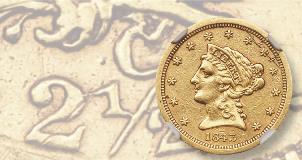Charlotte Mint gold coin offered in British auction
- Published: Jun 26, 2025, 10 AM

One of just 7,469 1860-C Coronet gold $2.50 quarter eagles known to have been struck at the United States Branch Mint in Charlotte, North Carolina, is slated to cross the auction block July 9 in London, England, in a sale by the Stanley Gibbons Baldwin’s auction house onsite at 399 Strand and online at https://sgbaldwins.com/en-GB.
The 1860-C quarter eagle example being offered was graded and encapsulated as About Uncirculated 58 by Professional Coin Grading Service.
PCGS records encapsulating 106 submissions of 1860-C quarter eagles, with the its highest grade assigned being Mint State 61. Five submissions, including this one, are certified as AU-58.
The Stanley Gibbons Baldwin’s pre-sale estimate for the offered PCGS AU-58 example is £5,000 to £7,000 ($6,755.20 to $9,457.28 in U.S. dollars).
The Coronet gold $2.50 quarter eagle series was designed and engraved by Christian Gobrecht, chief engraver of the United States from 1840 to 1844.
Historical importance
The Charlotte Mint was the United States’ first Branch Mint.
In the spring of 1831, merchants and miners from around North Carolina petitioned Congress for a Branch Mint in the region, to eliminate risks incurred transporting gold to Philadelphia for refining and conversion into planchets for coining. Three years passed before a response was delivered, when the United States Treasury Department initiated the investigation of local private coining operations.
On March 3, 1835, Congress passed enabling legislation to establish three Branch Mints at various distant point, including one at Charlotte, in Mecklenburg County, North Carolina, for the coinage of gold only.
The act signed into law by the seventh president of the United States, Andrew Jackson, also authorized Branch Mints at Dahlonega, Georgia, and New Orleans, Louisiana.
The Charlotte Mint opened for business on July 27, 1837. Only raw gold was processed and refined, and on March 28, 1838, the first $5 gold half eagle was struck. Later that year, $2.50 quarter eagles were minted, and in 1849 production started on a small gold dollar.
All gold coinage from this Mint is distinguished with a single C Mint mark.
Seized by the Confederacy during the American Civil War (along with the New Orleans and Dahlonega branches), the Charlotte Mint was eventually converted into a hospital and military office space.
Towards the start of the Reconstruction Era, it was used as offices for federal troops, and then became an assay office, which it remained until 1913.
From 1917 to 1919, the Charlotte Women’s Club met in the building, which also served as a Red Cross station during World War I.
In 1931, when the Charlotte Mint building was to be razed, a private coalition acquired the structure from the U.S. Treasury.
The coalition and its supporters relocated the building to a site several miles east of downtown Charlotte, to the historic neighborhood of Eastover, where in 1936 it was dedicated as the Mint Museum of Art, the first art museum in North Carolina.
The Mint Museum displays a wealth of art and precious pieces, and boasts a reference library of more than 15,000 volumes, a theatre for lectures and performances, and a display of a complete collection of gold coins minted at the Charlotte Mint.
Certification
Of the 106 1860-C quarter eagles certified by PCGS, the highest graded piece is MS-61.
Numismatic Guaranty Co. has certified 172 of the 1860-C quarter eagles, the highest example an MS-63 coin.
ANACS has certified 36 examples, the highest in AU-53.
Certified Acceptance Corp. Grading has certified a single example, graded AU-55.
Connect with Coin World:
Sign up for our free eNewsletter
Access our Dealer Directory
Like us on Facebook
Follow us on X (Twitter)
Whether you’re a current subscriber or new, you can take advantage of the best offers on magazine subscriptions available in digital, print or both! Whether you want your issue every week or every month, there’s a subscription to meet your needs.
Community Comments
-
US Coins Jun 14, 2025, 9 PM
Subscription options open for 2025-S Silver Proof set
-
US Coins Jun 14, 2025, 1 PM
Military privy marks on 2025 Proof American Eagle dollars
-
US Coins Jun 13, 2025, 9 PM
Mint forecasts cost reductions in FY 2026 budget
-
US Coins Jun 13, 2025, 1 PM
July sale date for 20-coin 2025 Uncirculated set








